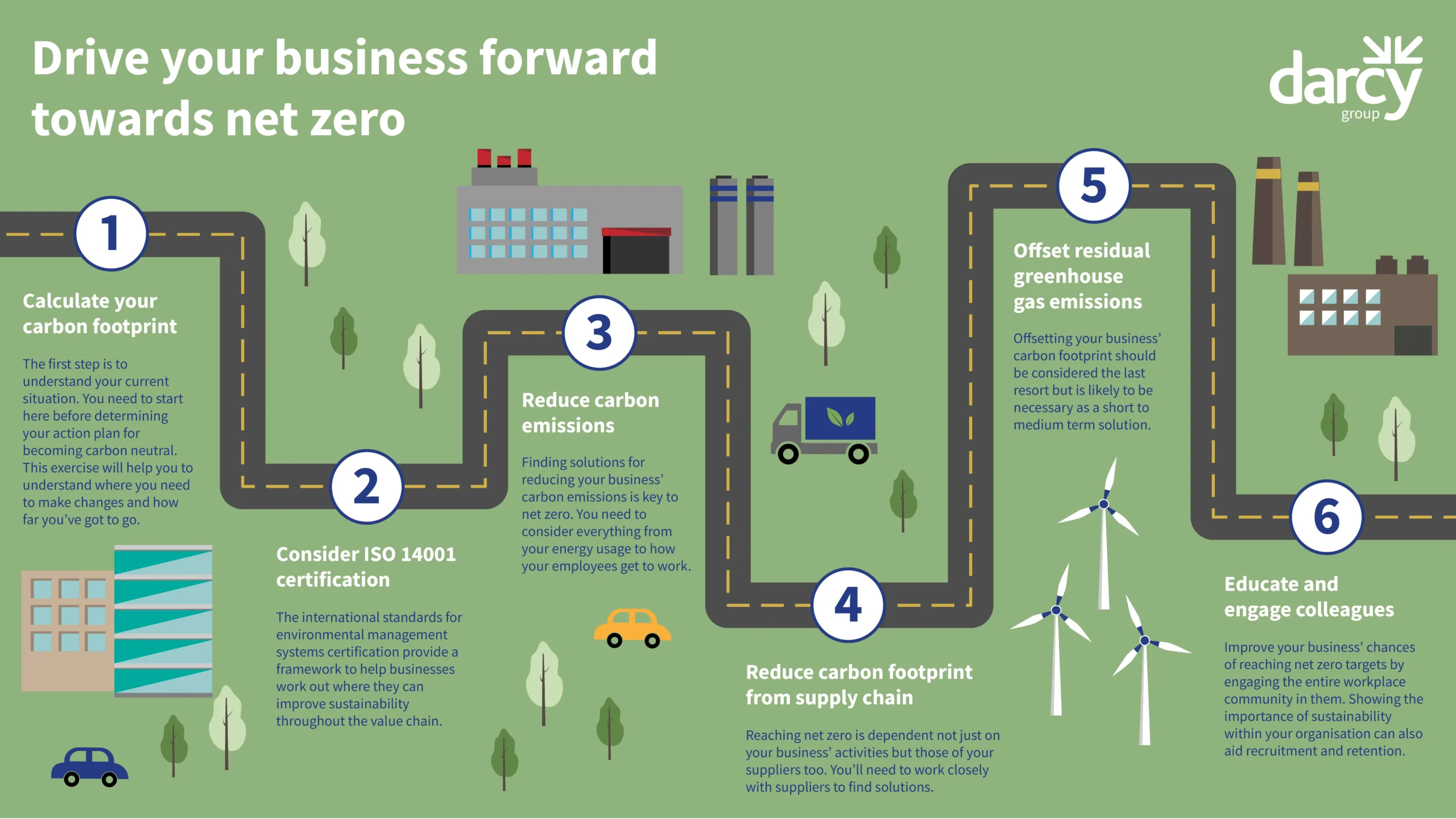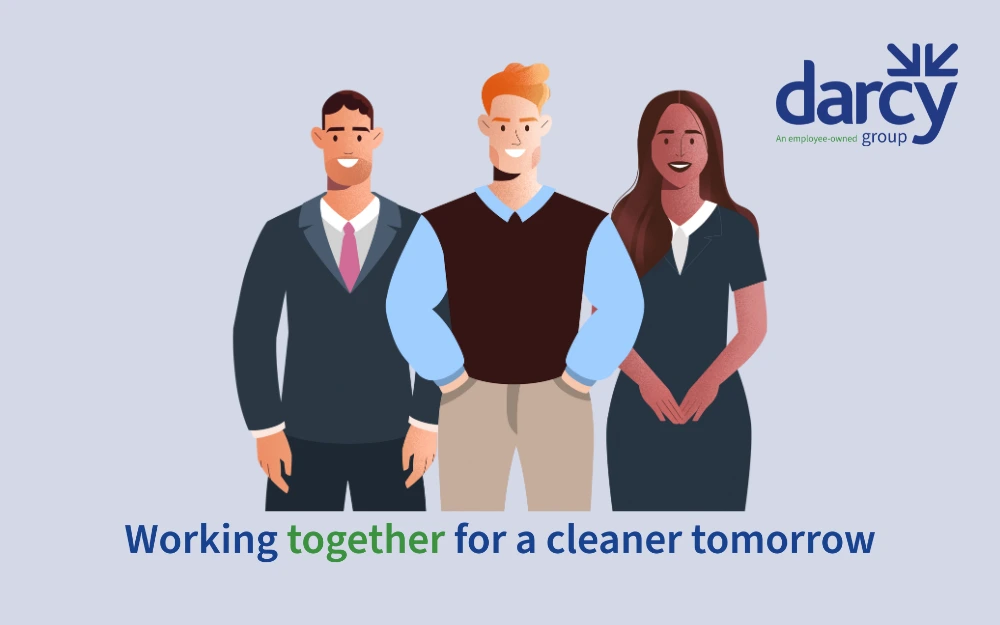
The government has committed the UK to achieving ‘net zero’ emissions by 2050. But what is the meaning of net zero? It’s the legally binding commitment that as a nation we will not be putting any more greenhouse gases into the atmosphere than we take out. The pumping of greenhouse gases into the atmosphere over the last 150 years is the biggest contributor to climate change.
The net zero commitments are designed to prevent global warming from reaching the Paris Agreement goal of 1.5° C above what it was before the Industrial Revolution. We’re already at 1.1° C, according to the Intergovernmental Panel on Climate Change (IPCC)’s latest report.
In November 2022, Accenture reported that although “over a third of the world’s largest companies are committed to net zero, nearly all of them will fail to achieve their goals if they don’t at least double the pace of emissions reduction by 2030”.
Research by Veolia in 2021 found that 42% of UK businesses are feeling overwhelmed by the steps they need to take to reach net zero.
How do we turn this around?
Measuring your business’ carbon footprint
Your business has committed to reducing carbon emissions. What next? Before you can set out what you need to do to reduce those emissions, you need to understand your current corporate carbon footprint.
Carbon emissions are classified under three categories, called scopes.
- Scope one is direct emissions from fuels and processes that are owned or controlled by an organisation, including emissions from a fleet of vehicles.
- Scope two is indirect emissions from the use of direct energy sources, including energy consumption and the use of refrigerants in fire protection systems and air conditioning.
- Scope three is indirect emissions that are a result of the organisation’s activities but not under its direct control. These occur both up and downstream in the value chain and include business travel and employee commuting.
This reads like a huge undertaking, and it is. Luckily there are a myriad of tools available to help you. Some of these are free, whereas others are paid for. You’d need to compare the tools available and decide which would work best for your company. If you Google “business carbon footprint calculator” you’ll be presented with various options. The data that you’ll receive about your current carbon footprint will allow you to:
- Work out which initiatives would have the highest impact
- Enable you to develop a carbon reduction strategy
- Report on carbon measurements and reduction progress with customers, investors, regulators and employees.

Consider ISO 14001 Environmental Management Systems certification
Although ISO 14001 is by no means compulsory, it could provide you with the framework your organisation needs to measure and manage sustainability as you work towards your net zero goals. You can utilise the requirements of ISO 14001 certification to identify areas where your organisation could be contributing to climate change, which will enable you to make a plan for reducing your organisation’s carbon footprint and achieving net zero goals.
Your organisation’s carbon footprint is affected by the carbon emissions throughout the supply chain, including the production of raw materials, transport and waste disposal. You also need to consider how the product and any packaging is disposed of by the end user. ISO 14001 provides a framework for managing your supply chain with environmental impact in mind.
Another benefit of ISO 14001 is the knowledge that an external auditor is going to come in and go over your environmental management systems with a fine-tooth comb, and the prospect of losing your certificate if you fail the audit can help put pressure on your organisation to find the budget and resources needed.
ISO 14001 revolves around helping organisations to improve their environmental performance through using resources more efficiently and reducing waste. It’s suitable for all types and sizes of organisations.
Where to start with reducing carbon emissions in your organisation?
Monitor your energy usage and tariff
As part of scope two of calculating your carbon footprint, energy consumption is an area that you can work to reduce. Carry out an audit of energy consumption to work out where you can make savings. Part of your carbon footprint will be from the type of energy you are using. Scrutinise your energy tariff and compare alternatives so you are using energy from renewable sources at the best possible price.
Save using low or no cost measures
Not all energy-saving measures are going to require a long-term investment. There are some measures you can take that will reduce your organisation’s consumption quickly and easily.
How often is equipment left turned on unnecessarily? We’re told not to leave electrical items on standby in our homes, it’s no different in the workplace. You can start by enforcing the turning off of computers at the end of the day.
Automatic, motion-detection lighting systems means lights are only on when needed. Also, switching to more energy-efficient lighting such as LED will reduce your energy consumption.
When replacing appliances and equipment, opt for the most energy-efficient ones as possible.
Invest in long term energy savings
There’s no getting away from the fact that for major energy savings, you are going to need to invest. At one end of the scale, that might be replacing your fleet of vans with EVs and insulating your buildings to reduce heating costs. At the other end, would be a project such as replacing the Tata steel blast furnaces with new electric arc furnaces at a cost of £1.25billion.
The government’s Energy Technology List features over 8,000 energy efficient products including machinery for specific sectors.
Generate your own energy
Could you generate your own energy onsite? By adding wind turbines and/or solar panels to your facilities you can generate your own electricity, reducing your reliance on energy companies. The renewable energy created on site would have zero carbon emissions and something like a wind turbine would act as a giant signpost for your company’s green credentials.
Reduce office waste
How much are you paying for waste collection and confidential waste shredding? Making your offices paperless and improving recycling will reduce emissions caused by waste collections and the proportion of waste that goes to landfill.
Consider how employees are getting to work
Carbon emissions through employees commuting to work need to be considered as part of scope three. What initiatives could you put in place to encourage more sustainable methods of getting to work?
A lift-share scheme could be relatively easy to administer and would encourage colleagues to share the drive to work with colleagues who live nearby or along their route. From 2002 to 2018, over 60% of car and van journeys were made with a single occupant, in England. The main incentive would be the cost-savings to them, which would be beneficial during this cost-of-living crisis.
Registering for a cycle-to-work scheme provider will enable your employees to spread the cost of a new bike through monthly instalments taken through payroll, before tax and other deductions. You’ll organisation pays for the bike upfront and is repaid through salary sacrifice. The reduced employer national insurance contributions mean employers save about 13% on the cost of the bike and will benefit from a healthier employee who produces less carbon emissions and doesn’t need a parking space. The government has published guidance on implementing a cycle-to-work scheme.
Is your site hard to reach by public transport? Could you offer a shuttle bus from a central point such as a railway station to make it easier for your employees to use public transport? A minibus could shuttle back and forth during peak times and could potentially be used as a lunchtime shuttle to take employees into a town centre.

Reducing the carbon footprint from your supply chain
The greenhouse gas emissions associated with producing your product or service are only part of the story. You also must consider the emissions associated with producing and receiving raw materials, transporting your finished goods and the disposal of waste, including by the end user.
If manufacturing products, the raw materials needed will be an important part of the design phase. To minimise the impact of your product on the environment, you should consider choosing the most sustainable raw materials. Set ecological requirements for your suppliers and choose those that report on their carbon emissions and use renewable energy. Another thing to consider is how easy the materials are to recycle.
In 2021, the Darcy Group made the decision to manufacture PCBs in the UK rather than importing. We also make a conscious decision to use local suppliers where possible, to reduce our carbon footprint.
At the other end of the supply chain, you have the transportation of your products to your end users. To reduce emissions from transportation, choose a logistics partner committed to reducing their carbon footprint and being more sustainable. Consider the packaging you use. Will reduced packaging enable you to fit more products on a pallet, for example? Can you collate shipments and reduce how many times you make deliveries?
When it comes to waste disposal, it’s not just the disposal of the waste creating during your processes that you need to consider, it’s how your end users dispose of any waste generated by your products, and indeed how your product itself is disposed of at the end of its life.
One example of a company that has made its waste disposal sustainable is Kanes Foods. The manufacturer set itself a 100% landfill diversion target – and achieved it four years early – while working with Veolia to manage its waste. In doing so, the manufacturer has reduced its carbon emissions.
The Darcy Group reports on packaging usage annually, which helps us to target reducing the amount we use. Reduced packaging means less waste disposal for the end user and fewer raw materials required in manufacturing the packaging.
Offsetting greenhouse gas emissions
Becoming carbon neutral is going to take time and may not be 100% possible for years to come – or possibly at all. To reach net zero, businesses will be expected to offset any residual greenhouse gas emissions.
Carbon offsetting is removing carbon dioxide from the atmosphere to counter what your business has put in. Offsetting your carbon emissions should always be the last resort after you’ve done everything technically and financially possible to reduce your emissions.
There are various carbon offsetting schemes available. They tend to either involve investing in projects with the aim of reducing future emissions or investing in reforestation projects that’s creating carbon sinks to absorb more carbon dioxide from the atmosphere. You can review the Environment Agency’s review of offsetting approaches to help you decide what would work best for your organisation.

Education and engagement
To meet net zero 2050 targets, the whole organisation needs to buy into it. For everyone to work together, every colleague needs to understand how their efforts will affect the overall goals.
Company-wide education on the importance of net zero and how it affects people at all levels is vital. You can also involve employees at an early a stage as possible to engage them in thinking about ways to reduce emissions. By engaging employees, they will feel more ownership over the targets set.
The V&A Museum has created a sustainability-focused learning programme to further its employees’ knowledge on various aspects of sustainability to aid the embedding of sustainable practices across the organisation.
What support is needed for businesses to achieve net zero?
A YouGov survey conducted on behalf of Veolia asked over 1,000 senior business decision-makers about their net zero strategies. For those businesses with a net zero strategy, the most popular types of support the business leaders would like to see are investment and Government legislation. Only 12% said they did not need any external support.
To achieve carbon neutrality, net zero needs to be at the heart of your business’ strategies. And it’s going to require investment, however only 56% of those businesses with a net zero strategy in the YouGov survey have a budget set to deliver their carbon strategy. Without a budget, it’s going to be impossible to achieve net zero targets. Even buying a new recycling bin for the staff canteen will need to come from a budget.
There is financial support available for businesses to help become more energy efficient. Visit the UK Business Climate Hub to find available finance and support.
So, what now?
Businesses need to act now to implement plans to reduce carbon emissions if we’re going to achieve net zero by 2050 and avoid climate disaster.
Start by understanding your current carbon footprint and use that to develop a strong roadmap to becoming carbon neutral.
Let’s recap the key steps:
- Calculate your current carbon footprint
- Use your calculation to find where you need to make reductions and to guide your strategy
- Consider using the ISO 14001 certification to help you identify where your business can be more sustainable
- Involve your colleagues so they are engaged with the strategy from an early stage
- Put your strategy in place and report on your progress to key stakeholders
- Look for financial support to help you become more energy efficient, if needed.
We need to work together against climate change. Let’s start now.
Table of Contents
- Measuring your business’ carbon footprint
- Consider ISO 14001 Environmental Management Systems certification
- Where to start with reducing carbon emissions in your organisation?
- Reducing the carbon footprint from your supply chain
- Offsetting greenhouse gas emissions
- Education and engagement
- What support is needed for businesses to achieve net zero?
- So, what now?
Sign up for the latest news and offers


